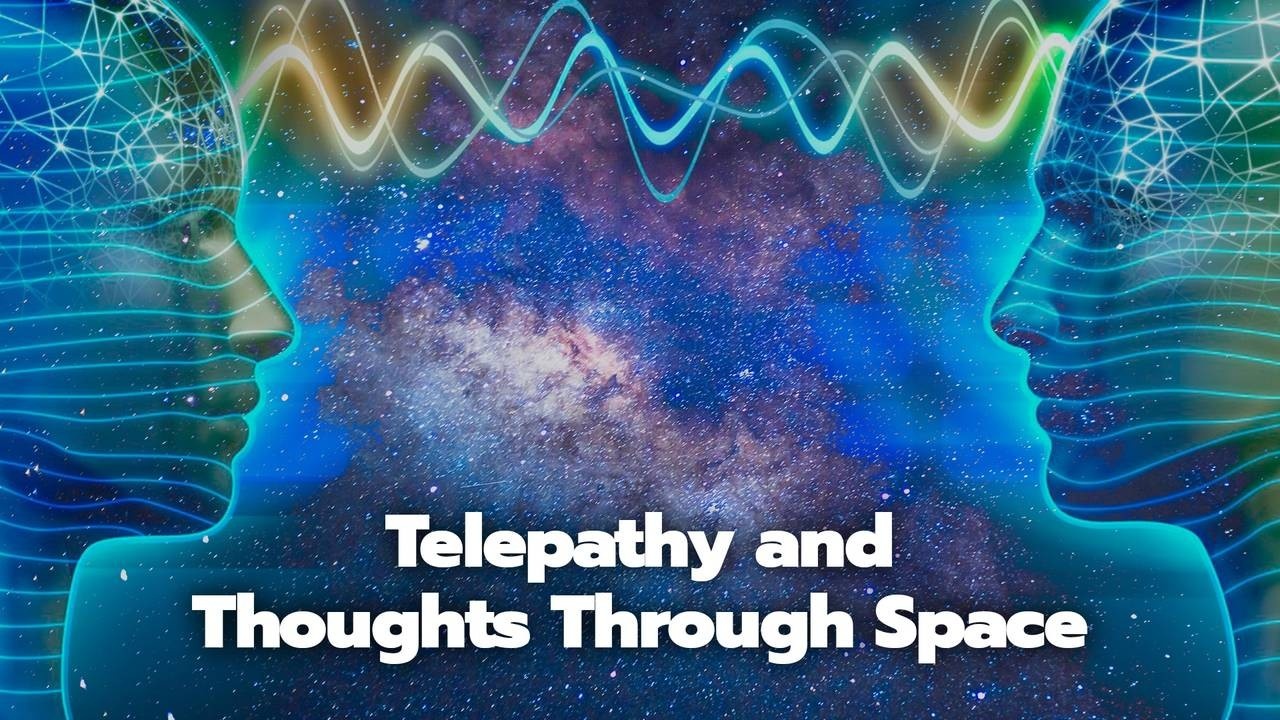Telepathy And Thoughts Through Space

Those who reject even telepathy have reached the point where they are impugning either the honesty or the sanity of several thousand scientific researchers on all major continents over a period of decades. Such expedient ways of disposing of data are shared only by the most ardent anti-Evolutionists among the Fundamentalist sects.
—R.A. Wilson, Cosmic Trigger
Telepathy Background
The term “telepathy” was coined in 1882 by Frederick W.H. Myers, a founding member of the London Society for Psychical Research (SPR).
The word means “feeling at a distance,” though this is not usually how the term is deployed. Telepathy is essentially mind-to-mind contact, or the exchange of information between two different consciousnesses separated by an arbitrarily large distance (it doesn’t matter how large). Though some narrow-minded folk would claim any discussion of telepathy is “unscientific” by default, many years ago there were eminent scientists who not only recognized its existence but sought to understand the phenomenon.
The first studies of telepathy were based on collections of spontaneous experiences, with 1886 seeing the publication of the seminal classic Phantasms of the Living, by the British scholars Edmund Gurney, Frederick Myers, and Frank Podmore—who actually took the time and effort to analyse all reports to identify the best and most reliable cases for publication and eliminate the fraudulent.[1]
Over a decade later, the eminent chemist and physicist Sir William Crookes—also an avid and meticulous researcher into “paranormal” phenomena—spoke on telepathy before the Royal Society at Bristol, England, in 1898. This address was, in the words of occultist Swami Panchadasi (a.k.a. William Walker Atkinson), “made before an assemblage of distinguished scientists, many of them rank materialists and quite skeptical of all occult phenomena.”

Crookes, facing this gathering as its president, expressed the view that it is a “fundamental law…that thoughts and images may be transferred from one mind to another without the agency of the recognized organs of sense—that knowledge may enter the human mind without being communicated in any hitherto known or recognized ways.”[2]
If telepathy occurs, he continued, “we have two physical facts—the physical change in the brain of A, the suggestor, and the analogous physical change in the brain of B, the recipient of the suggestion.”
While Crookes would eventually be vindicated in these comments by the development of the EEG and other modern technology and experimental designs (as I detail in THE GRAND ILLUSION – BOOK 1), he assumed that “[b]etween these two physical events there must exist a train of physical causes.”[3]
We can accept this explanation if we modify our definition of “physical” to include “subtle energies” (such as superluminal torsion/scalar fields), and the plasma-like particulate matter of the various occult densities (etheric, astral, mental, etc.).
Technically, since all information exists everywhere in a holographic universe, the telepathic communication - in line with current thinking in quantum physics - is not so much about transferring information between two separate locations as might occur in a local-realistic paradigm, but about the "sender" mentally triggering the simultaneous or "synchronistic" emergence into awareness of the same (latent) data in the mind of the recipient.
However, accomplished seers would probably point out that they can literally see the transference in the form of (superluminal) beams or currents of life travelling between sender and receiver. For instance, when someone thinks of a faraway place, they generate streams of light connecting to that location. These phenomena are not recognised within the mainstream physics paradigm, of course.
In the modern world, the commonest kind of human telepathy occurs in connection with telephone calls, according to biologist and paranormal researcher Rupert Sheldrake. Over 80% of people claim to have thought of someone for no apparent reason, who then phoned them; or that they have known, in a telepathic sort of way, who was on the phone before answering it. Sheldrake reports that controlled experiments have provided highly statistically significant repeatable positive results.[4]
Many people (probably about 80%!), however, will need no convincing of the fact, as repeated personal experience has a way of making experimental proofs a bit redundant.
A World First Experiment
In 1942 the remarkable, though little-known, book on telepathy Thoughts Through Space, by Australian-born aviator-explorer Sir Hubert Wilkins (1888–1958) and American author, playwright, and “sensitive” Harold Sherman (1898–1987), was published.
It detailed the first experiment (conducted from late 1937 through to early 1938) of its kind: a long-distance and long-term telepathy experiment where Wilkins, who was aiding in the aerial search for a missing Russian craft and its crew in the Arctic, would attempt to telepathically send information regarding his activities to Sherman, who would attempt to receive the messages and record them. This would take place over a period of some five months.

However, as it turned out, Wilkins never got the opportunity to take time to deliberately send any impressions to Sherman, who faithfully conducted his “psychic vigil” each night at the same time, ever unaware of Wilkins’ situation or activities. What Wilkins did instead was to record events and details in his log, this being the usual habit with an explorer. When Wilkins returned from the Arctic, his dated log was compared with the dated impressions of Sherman so the latter’s psychic accuracy and reliability could be assessed.[5]
Early in the book, Wilkins made a point of noting that, a) Sherman had already demonstrated his ability to receive impressions without the necessity of Wilkins’ consciously willing thoughts to him at the time of their scheduled “sittings,” and, b) Sherman could respond directly to Wilkins’ thoughts on the occasions he was able to keep their “psi appointments.”[6]
The role of emotion was significant in these experiments (as it is in many psi experiments), as the two participants ultimately acknowledged. Wilkins noted that despite his inability to regularly keep to the appointed “sending” time for the experiments, he did continue his habit of thinking the unusual incidents strongly to Sherman. When Wilkins was anxious, Sherman seemed to be particularly effective at detecting his thoughts.[7]
Wilkins also agreed with the occultist’s axiom that the intensity of a sender’s emotional reaction to what is happening to him, or has happened, determines the degree of intensity of the “thought-waves” discharged.[8] (In my book The Grand Illusion, I have portrayed these thought waves as torsion/scalar waves in the aether/time-space/implicate order.)
Also worth noting is that in some ways, this epic experiment—lasting as it did over five months—was something of a precursor to what would later become known as remote viewing. It also featured elements of prevision, and showed the unpredictability so common to psi functioning, thus blurring the lines* between telepathy in real time and other forms of clairvoyance. This tended fuelled Sherman’s uncertainty as to precisely what he was seeing at the precise moment of seeing.
Sometimes visions would turn into previsions, precipitating out of the aether days later without apparent warning. This was a complicating factor at times, as was the initial lack of feedback for Sherman, which caused him a degree of anxiety (was he “hitting” more than missing?). Nevertheless, the experiment overall can only be described as a stunning success, with some indisputably spectacular hits by Sherman to be found scattered throughout.
- The term “general ESP,” or GESP, became popular to reflect the fact that it was (and still is) difficult to distinguish cleanly among the various forms of perceptual psi. Source: D. Radin, The Conscious Universe, HarperOne, 1997, p 67. How is one to know, for instance, if the image one perceives relates to past, present, or future? Sometimes it just isn’t immediately clear. In time-space/aether/implicate order, past, present and future are present and accessible. For more discussion on this, see The Grand Illusion: A Synthesis of Science and Spirituality – Book 1
Official Results: Telepathy and Thoughts Through Space Proved
Sherman sat three times a week to act as receiver, depositing copies of his nightly impressions to third party witnesses to ensure there could be no question of his having failed to record his impressions before receiving Wilkins’ log. Let’s look at some of the data.

Sherman’s report of Wilkins’ activities for February 14 reads:
Impression you talked three times before different interested groups since arrival at Edmonton—first time before some luncheon club—like Rotary Club—you have found a motor—you plan to take off with it tomorrow or Wednesday, if weather permits. You have dinner with three men and their wives…One of Edmonton’s wealthiest and most prominent men has entertained you and given you some assistance relative to the expedition—word McKenzie flashes to my mind—is there a company of that name supplying you with plane?
Seem to see you as guest of Church Brotherhood…Sunday occasion—you called on to speak—you have appointment with two men who will take you to some plant or place where you will see the packing of the equipment.[9]
Keep in mind that Sherman had been receiving little feedback on previous recordings prior to this session, and had not been forewarned of any of these activities, making it all the more remarkable that Wilkins was able to subsequently confirm every detail, including the fact that McKenzie Airways were furnishing the plane that would fly the new engine back to Aklavik. All of these things took place between February 10 and 14.[10]
As noted, sometimes the information being received by Sherman was a blur of present (or recent past) information and information pertaining to some point in the future. Wilkins stated that in his March 1 record Sherman had recorded almost all of his most prominent thoughts as well as describing the conditions Wilkins experienced.[11]
 The latter part of the entry from Sherman mentions liquor in connection with a commercial interest (possibly a company seeking his endorsement). Sherman states that Wilkins is wondering whether they will offer him enough money for it, and then moves on to things flight-related. He suggests checking the oil and gas lines leading to the engine as a possible source of trouble—“something appears to get clogged or choked” as a result of the low ambient temperature.
The latter part of the entry from Sherman mentions liquor in connection with a commercial interest (possibly a company seeking his endorsement). Sherman states that Wilkins is wondering whether they will offer him enough money for it, and then moves on to things flight-related. He suggests checking the oil and gas lines leading to the engine as a possible source of trouble—“something appears to get clogged or choked” as a result of the low ambient temperature.
Wilkins’ analysis of Sherman’s psi report confirms that Hiram Walker had indeed sought Wilkins’ endorsement for a certain whiskey, but did not offer sufficient remuneration to garner Wilkins’ advocacy. It was the one time that year that Wilkins had received such an offer.
As for Sherman’s concern over gas and oil lines, sure enough, the next day during flight, the feed on the automatic control did clog. Towards evening, the oil temperature indicated some clogging of the line, according to one of Wilkins’ collaborators (Cheeseman) on the plane with him.[12]
Evidently, darkness proved to be an aid in Sherman’s sittings, eliminating visual stimuli so he could become more receptive to the information filtering through from his subconscious mind.[13]
Sitting in darkness to receive psi information is a good and standard way to increase the psi signal to noise ratio (similar to Ganzfeld tests).
An interesting fact to note is that after some time of sitting three times a week for his sessions, Sherman had trained his subconscious to feed him psi information more consistently.
He commented that his mind had become so highly sensitized and habituated to the psi task that it continually brought him un-asked-for impressions and “unusual mental flashes.” These flashes appeared sometimes to come from the mind of anyone he focused his attention on, regardless of the fact that there were unbidden insights he did not seek.
There are many pieces of evidence that demonstrate that the psi faculty, like our muscular system, is responsive to training. This has been known to mystics and occultists for many centuries.
As well as this, Sherman suffered serious ill health effects because of his other commitments, which left him virtually no rest and recovery time. We need not go into Sherman’s exact method in eliciting his results, but it is worth noting that during the sessions he could feel his mind “contact” Wilkins’ mind, he sensed a force, line, or stream of energy which seemed to connect the two subconscious minds of the men. During the sittings when he felt this sensation the strongest, he got his best results.[14]
A conclusion reached by both men (and one in full accordance with occult thought) was that the degree of intensity of emotional reaction to external experience determines the intensity of the thought force projected. In their view, human emotions were the power source behind the electrical currents of the brain.[15]
A recurring motif in “paranormal” and parapsychological research is the important role of emotion, creative force that it is.[16]
Sherman also noted that he sensed thought impressions at two places in his body: the brain (center of crown and third eye chakras) and solar plexus (where the manipura chakra is).[17] He would get a nerve reaction in the pit of his stomach (not unlike that felt when one receives a sudden shock or becomes anxious), which he came to realize always accompanied a genuine telepathic communication.[18]
Dr. Hiroshi Motoyama has connected the lower three chakras (one of which is the solar plexus chakra/manipura) with passive or receptive psi abilities, such as Sherman employed in this telepathy experiment.[19]
On top of Sherman’s amazingly accurate reports of Wilkins’ far removed activities either as they happened or soon after, he also sensed events yet to happen to Wilkins, as previously noted. Wilkins only had two accidents occur involving his plane during his five months away, and Sherman sensed both ahead of time......
[Continued in The Truthiversity]

